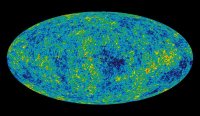

Does the universe have a shape?
In a few years past, there was some recent interesting theorizing and speculation outlined in a National Geographic article. The shape of the universe was theorized to be like a dodecahedron - or even like a "soccer ball". This determination seems to have been partly made by observations of the CMWB (cosmic microwave radiation background). That is if one could travel outside of the proposed boundaries of the universe, one would see a boundary shape like a dodecahedron.
This sounds a bit like a cosmic Pandora's box. If one were to travel beyond this theoretical boundary, well just what would one find surrounding the dodecahedron? Dark matter? Dark energy? It seems it wouldn't be anything like our "normal" universe to which we are accustomed.
Could this be a true source for the dark (negative) energy of universe that provides for the force for the continuous expansion and acceleration of space? Was this the energy source for the inflation of the universe after the Big Bang?
One could speculate - I suppose - that for an initial singularity to come into existence (and then explode) that there had to be an initial boundary condition created by an event horizon. In this case, an initial event horizon might actually be an open yet spacelike curve. The initial hyberbolic spacelike curve existed outside of a timelike curve. This curvature provided a degree of freedom for the initial event horizon to form.
This one degree of freedom and initial event horizon created the initial singularity from which exploded the Big Bang. Dark energy provided by the negative hyperbolic spacelike curve provided the inflation needed to power the Big Bang. The negative hyperbolic spacelike curve also created an opportunity for energy from the Big Bang to create initial embedded surfaces in the event horizon. These embedded surfaces probably had a positive curvature to bind to the intial negative spacelike curve, creating space. The acceleration created the effect of a timelike curve in the embedding of the new positive curvatures forming in the initial spacelike curve. In essence, these positive curvatures created the new effects of gravity and acceleration in the newly forming space which was to become the universe.
A boundary implied by the initial event horizon implies that the intial space created a growing open universe along with the newly formed forces of acceleration and gravitation.
To be continued...? 7/30/06




No comments:
Post a Comment